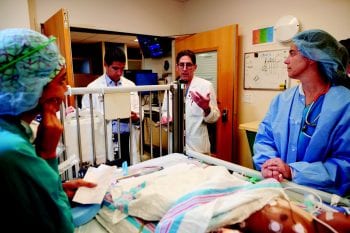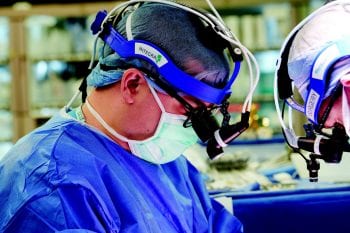Focus: Improve collaborative communications

Teamwork and communication are keys to improving patient safety. While that sounds like common sense, the reality is that, sometimes, medical specialists — even in related fields — work independently from one another. By working together, they coordinate care and share their successes, improving patient outcomes.
“Historically, there was a series of silos,” says Pirooz Eghtesady, MD, PhD, the Emerson Chair in Pediatric Cardiothoracic Surgery at St. Louis Children’s Hospital. “One week, surgery would present their complications at a morbidity and mortality (M&M) conference — the following week, cardiology. That presupposes we are completely separate when in reality we’re intertwined.”
When clinical teams collaborate effectively, according to an American Heart Association Scientific Statement, they can improve patient outcomes, prevent medical errors and improve efficiency.*† Eghtesady helped transition separate meetings by pediatric cardiologists, cardiothoracic surgeons and critical care physicians into a cohesive and collaborative team and the formation of the St. Louis Children’s and Washington University Heart Center.
Surgeon Peter Manning, MD, describes the Heart Center’s Outcomes Committee as the hub of analysis and patient safety efforts: It creates the agenda for the monthly M&M conference reviewing adverse outcomes, triages safety issues to various Heart Center committees or the hospital’s Go Team for hospital-wide concerns, and works to improve communication with other specialists.
Sharing best practices also makes patients safer. Eghtesady led, and Manning participated in, a study of a surgical pre-brief to improve surgical team communication. It mirrored team-based communications in commercial aviation with five components: a pre-brief the day before surgery, a pre-surgery time-out, an intraoperative post-brief, a care plan review when the patient arrives in the ICU, and a team post-brief. Before implementation, 100 percent of staff felt communication was inadequate. After strategy development, 98 percent of cases had pre-briefs, 85 percent had post-briefs and just 30 percent of staff noted the need for more communication.††
“The cardiac cath lab and electrophysiologists in cardiology have adopted our practice of doing pre-briefs before any procedure,” says Manning. “Everybody is empowered to be aware of what’s going on and to speak up if they feel things are going off script.”
*Scientific Statement From the American Heart Association. Patient Safety in the Cardiac Operating Room: Human Factors and Teamwork. Circulation. 2013;128:1139–1169.
†Neily J, Mills PD, Young-Xu Y, Carney BT, West P, Berger DH, Mazzia LM, Paull DE, Bagian JP. Association between implementation of a medical team training program and surgical mortality. JAMA. 2010 Oct 20;304(15):1693-700.
††Hoganson D, Boston US, Manning P, Eghtesady P. The Surgical Prebrief as Part of a Five-Point Comprehensive Approach to Improving Pediatric Cardiac Surgical Team Communication, World J Pediatr Congenit Heart Surg. 2014 Oct;5(4):640-2.
Highlights
Pediatric cardiothoracic surgeon Aaron Abarbanell, MD, MS, has introduced minimally invasive cardiac sympathetic nerve denervation as a treatment for select types of ventricular tachycardia at St. Louis Children’s Hospital. Candidates for the procedure have implantable cardioverter-defibrillators (ICDs) and are on two anti-arrhythmic drugs but still have recurrent shocks from their ICDs. The minimally invasive procedure reduces the sympathetic nervous system stimulation of the heart, which can trigger ventricular tachycardia. Patients can go home the day following their procedure.
Vipul Sharma, PhD, a post-doctoral research associate in the lab of Pirooz Eghtesady, MD, PhD, led research finding that a common virus called coxsackievirus B may cause heart defects during early stages of pregnancy. Researchers studied the virus in animal models but hope the research may help scientists develop prevention strategies for women. Sharma presented the findings at the American Heart Association’s Basic Cardiovascular Sciences Scientific Sessions in August.
A study led by Section Chief Pirooz Eghtesady, MD, PhD, found that while progress has been made on multiple fronts, children needing lung transplants still have longer wait times and higher death rates while on the wait list than do adults. Children face special challenges related to size matching of donated lungs and are at higher risk of contracting bronchiolitis obliterans, or obstruction of the airways due to inflammation, which is the main risk factor for long-term survival. Understanding the biology better could enhance treatment and survival. St. Louis Children’s Hospital is among a handful of transplant centers in the world that perform pediatric lung transplantation fpr end-stage pulmonary disease.
